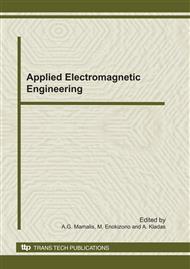p.345
p.355
p.360
p.369
p.381
p.391
p.399
p.407
p.415
Optimal Design of the Electro-Magnetic Actuator for High Voltage Circuit Breaker
Abstract:
The motor-spring and hydraulic actuators have long constituted as a mechanism for HGCB, regardless of the fatal disadvantages of the malfunction. Although many attempts have been made to cope with them, there is no alternative to replace this mechanism. This paper presents a new type of the electric actuator, electro-magnetic force driving actuator (EMFA) for high-voltage gas circuit breaker (HGCB) and describes the principle of the optimal design. Auto-Tuning Niching Genetic Algorithm combined with deterministic method (Pattern Search Method) is developed to reduce the number of object function calls and used for the optimal design. Fabrication and experiment were performed in order to prove the applicability for HGCB overall class. In comparing the experiment with simulated data, it is confirmed that analysis of the dynamic characteristics of EMFA is appropriate for design.
Info:
Periodical:
Pages:
381-390
Citation:
Online since:
December 2010
Authors:
Price:
Сopyright:
© 2011 Trans Tech Publications Ltd. All Rights Reserved
Share:
Citation:


